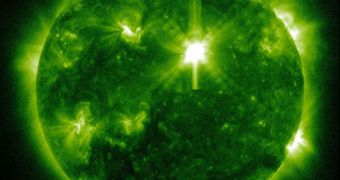People living in New York City will have the chance to look up in the sky and see northern lights staring them right back in the face. The odd events are the result of a massive solar flare, which was produced by the Sun on March 9.
The solar storm that resulted released vast amounts of material, mostly highly-energetic particles that are currently en route to our planet. They have already begun slamming into Earth's magnetosphere, and will continue to do so for the next couple of days.
Solar physicists say that the event took place at 6:23 pm EST (2323 GMT), and that the charged particle wave is currently on its way here. Based on the intensity of the solar flare, experts estimate the resulting auroras will be observable for latitudes as low as New York City's.
These events, called the Northern Lights, appear when solar radiation slams into the magnetosphere, a layer of Earth's atmosphere that is powered by the planet's magnetic field. It acts like a shield against radiation coming from space, and is one of the reasons why life is possible here.
When streams of particles collide with it, they literally start flowing alongside Earth's magnetic lines, creating drape-like auroras, whose movement speed is correlated with the intensity of the solar storm.
“This flare could make the Northern Lights visible as far south as Washington State, central Idaho, northern Wyoming, the Dakotas and east to Chicago, Detroit, NYC and Boston,” says Joe Rao.
“Of course, we have to hope that the subatomic particles emitted by the flare arrive at the Earth's vicinity during the nighttime hours and of course, that skies are clear!” adds Rao, a Space columnist.
Experts say that the solar flare was a Class X1.5 event, which is among the most powerful types of solar storms there are. The ejected material originates in an area located close to sunspot 1166.
A Class X2.2 storm took place last month, making the current event the second major storm in less than 30 days. Indeed, the Sun appears to be waking up from its prolonged solar minimum.
“After four years without any X-flares, the Sun has produced two of the powerful blasts in less than one month: Feb. 14th and March 9th. NOAA forecasters estimate a 5 percent chance of more X-flares during the next 24 hours,” Spaceweather experts report.
The previous event, which took place around Valentine's Day, was the most powerful flare to appear on the Sun in the last four years, experts said at the time.

 14 DAY TRIAL //
14 DAY TRIAL //